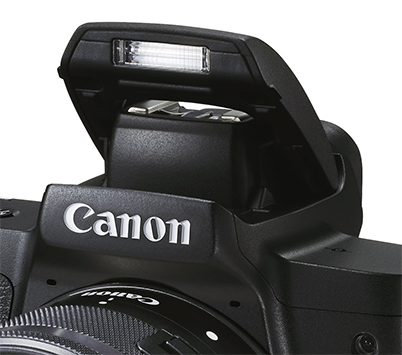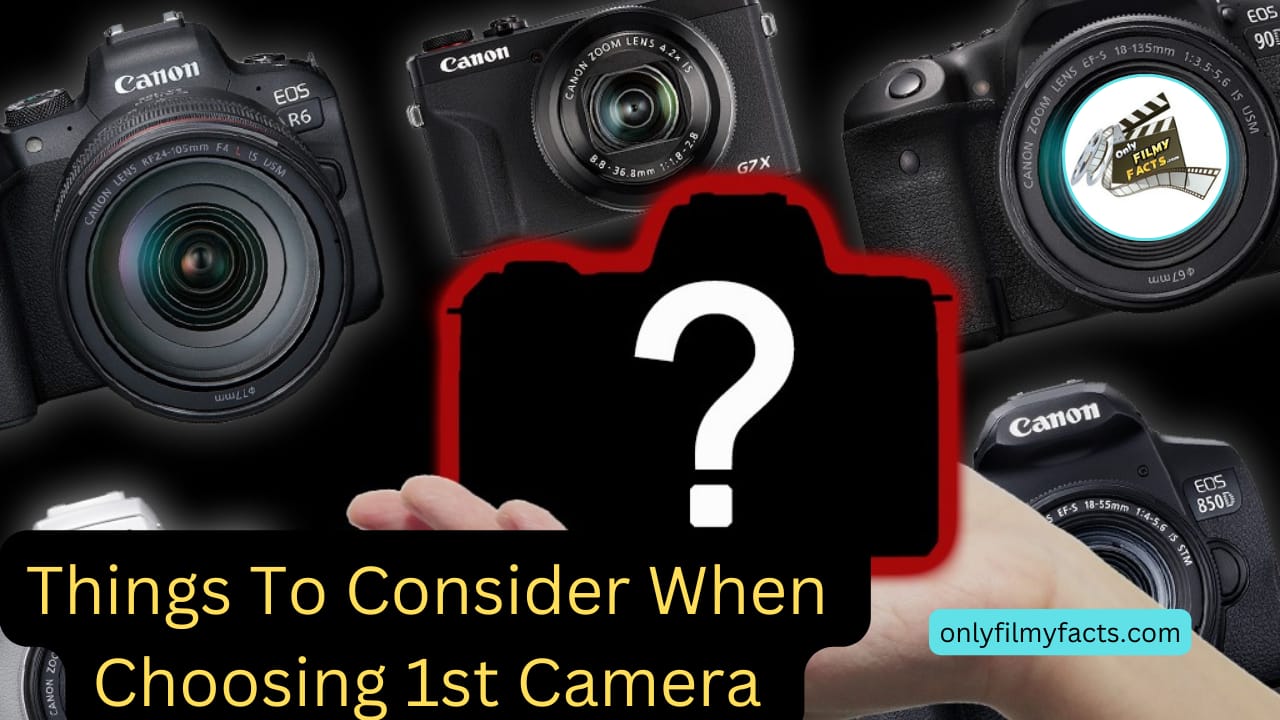Photography: You’ve made the decision to purchase your first dedicated camera, which is a significant step in your photographic journey. How do you pick the option that best suits your needs when there are so many to choose from, each with special features? Here, we share seven things to consider (other than budget) that will help you make a better decision.
1. Do I want the possibility of using different lenses?
Compact camera or interchangeable lens camera?
In case playing with different lenses is one of your primary motivations for owning a dedicated camera, you should consider purchasing Mirrorless and DSLR cameras, as they are capable of accepting interchangeable lenses.

Shot on the RF100mm f/2.8L IS USM
A long macro lens like the RF100mm f/2.8L IS USM lets you capture close-ups of small, sensitive subjects like butterflies from a comfortable distance away.
The kit lens that comes with your DSLR/mirrorless camera kit is usually a standard zoom or superzoom lens that covers most everyday subjects. But think about getting a compact camera if you want less upkeep or just like the idea of doing everything with one unit. The image sensors on the Canon PowerShot series are larger than those on the majority of smartphone cameras, with at least a 1-inch type. They also have features like the following that are found on DSLR and mirrorless cameras:
– Fast autofocus and tracking
– High continuous shooting speed
– Manual and semi-automatic exposure modes
– High ISO performance
– Wi-Fi and Bluetooth connectivity

Canon’s flagship compact camera, the PowerShot G1 X Mark III, offers a 24-megapixel APS-C size image sensor—the same as that found on many DSLR and mirrorless cameras. In case you want to try using an external flash, it also features a built-in flash, an electronic viewfinder (EVF), and a hot shoe that can accommodate a Speedlite.

With one lens, a mirrorless or DSLR can only offer a focal length range of 21–1365mm (in 35mm full-frame equivalent terms). This is far less than what the PowerShot SX70 HS, a superzoom compact camera, offers. It has an EVF, a built-in flash, and a form factor that resembles a mini DSLR.
Know this: the tradeoffs involved
If any of the following concerns you, a mirrorless or DSLR camera would be a better option:
Image quality
The small size of compact camera zoom lenses places restrictions on lens design. Special glass and other design elements are incorporated into high-quality interchangeable lenses to deliver optimal image quality.
Shallow depth of field and bokeh
The bokeh produced by a compact camera will likely not look as creamy under the same settings and shooting conditions because of the limitations of lens design combined with a smaller image sensor.

EOS M series camera + EF-M32mm f/1.4 STM
A mirrorless camera with a large aperture prime lens was used to achieve the distinctive foreground and background bokeh at f/1.4.
Room for growth
Acquiring proficiency with various lenses enhances photography skills and expands expressive possibilities. Even if you don’t now see their benefits, what happens if you do? You can always use the kit lenses with a DSLR or mirrorless camera and upgrade to a better lens later on when you’re ready. You will, however, have to make due with the compact camera.
If you are quite sure you want a compact camera, move on/skip to point 4.
2. Should I get an APS-C camera or a full-frame camera?
Budget, size, and shooting flexibility
Your next choice, if you’ve decided on an interchangeable lens camera, will likely be between an APS-C and full-frame image sensor.


A comprehensive article is necessary to fully explore this subject; you can learn more about it in Full-Frame vs. APS-C Camera: Which Should I Choose? You have more options among APS-C camera models if you need a smaller camera or are on a very tight budget because image sensor size typically influences both the camera’s size and production cost. However, if you’re looking to make a long-term investment in a camera that provides the greatest options, think about getting a full-frame camera.
3. Which lens mount should I go for?
Important if you intend to eventually replace your equipment
Your selection of lens mount and camera series is closely tied to whether you want to use an APS-C or full-frame camera. There are presently four lens mount systems available for Canon:
- RF mount for the EOS R mirrorless system
- EF mount for full-frame DSLRs
- EF-S mount for APS-C DSLRs
- EF-M mount for the EOS M APS-C mirrorless camera system
There are two types of RF mount lenses:
- RF lenses designed for full-frame EOS R cameras
- RF-S lenses made specifically for EOS R APS-C cameras
Any EOS R camera can accept both types directly, though the results may vary based on the image sensor.
The cross-compatibility of various lens and camera body types is displayed in the chart below:

1 Needs mount adapter
2 Compared to a full-frame camera, the field of view will be smaller.
3 The image will only be recorded using a portion of the image sensor.
If you plan to upgrade your equipment or add more lenses to your collection in the future, the lens mount will affect the selection of lenses available to you. For example, even though the EF mount lineup is well-established and has a wide selection of lenses, Canon is currently focusing on the new RF mount, which has opened up a lot of possibilities.
4. Is having a viewfinder important? If so, what kind?
Having one is useful, but it depends on your shooting style and preferences!
You may be wondering if you will regret selecting a mirrorless or compact camera without a viewfinder as you weigh your options. Ultimately, personal preference will determine it, but these are the advantages.

There are many compact cameras, such as the Power Shot SX740 HS, and some mirrorless cameras that lack an integrated viewfinder.
When it helps to have a viewfinder
- For shooting outdoors in bright daylight, when it gets difficult to see the back LCD screen
- To concentrate better on subjects
- For holding the camera in a more stable stance
- When taking pictures in dim lighting, to avoid distracting nearby individuals with the light from the LCD screen
What distinguishes an EVF from a viewfinder on a DSLR?
DSLRs display the image directly from the lens reflected in the mirror through the optical viewfinder (OVF). In the meantime, the Live View display on the LCD screen and the display on an EVF have both passed through the image processor. This allows you to preview the effects of your exposure, white balance, and colour settings and display more information.

Is the sun’s glare preventing you from seeing the rear LCD display? Rescued by the viewfinder! It is simple to see how various settings affect an EVF because the information overlay is essentially the same as the one on the back LCD screen. You can also use your finger to intuitively control the AF point without looking through the viewfinder if your mirrorless camera has Touch & Drag AF enabled. Just tap or drag your finger across the LCD touchscreen.
Benefits of an EVF
– Can preview exposure and colour settings
– Information display
– Viewfinder gain can improve your night vision.
– Features like enlarging an image to verify focus
– Doesn’t need a mirror; helps to keep camera small
Benefits of an OVF
– Direct, lag-free view of the scene
– Clearest image
– Consumes much less battery than an EVF
5. Does it have the interfaces and controls that I require?
Look for features such as a hot shoe, integrated flash, etc.
Not every camera has all the features you require because different cameras are made with different users in mind. Here are some examples of some of them:
Hot shoe

When using a camera that has a hot shoe, you can attach external accessories like Speed lites, which are useful to know how to use if you want to take better pictures of yourself skills or grow as a photographer. However, some entry-level cameras may not have one.
Built-in flash

It is handy to have an integrated flash for those moments when you need more illumination. Higher-end cameras, on the other hand, frequently lack one because the professional photographers for whom they are intended typically use Speed lites. Having a built-in flash also makes it harder to achieve the level of dust- and drip-resistant weather sealing required for professional use.
Simplicity or more direct controls?
All recent camera models feature a touchscreen, which makes navigating menus and controlling things like auto focus more convenient than before. However, you might also prefer the tactile feel and ease of use that come with having more dials and buttons that offer direct setting changes.


Designed with simplicity in mind, the EOS M200 is ideal for users who prefer minimal dials and buttons. However, More menu navigating will be necessary to obtain more precise control over some settings, though.


The many More sophisticated cameras, such as the EOS 90D displayed here, have a plethora of dials and buttons that can be intimidating at first, but with practice, they can help you respond to dynamic scenes faster.
Some other features to look out for
Their importance varies according to your inclinations, purchasing goals, and habits.
– Advanced video functions
– Live streaming
– Creative filters
– Manual focus peaking/Focus Guide
– Vari-angle LCD monitor
6. What do I plan to shoot?
Some Certain features are designed to cater to certain scenarios
Features that are crucial for landscape photography would not be the same for action photography. These are some popular photography genres along with the most important features.
Wildlife, action, and unpredictable subjects

Shot by @neo_ng_ig on the EOS R5 + EF300mm f/2.8L IS II USM
If you are buying a camera to photograph unpredictable subjects like birds in flight, pets, or sports, it helps to have a camera that responds and focuses quickly and accurately. Good autofocusing (AF) AF capabilities are especially helpful when you are using long, telephoto lenses since these intrinsically have a shallower depth of field that can make focus challenging. A fast continuous shooting speed is a bonus.
Did you know that the AF coverage of a mirrorless camera is typically better than that of a DSLR?
DSLR
*This image is merely for representation.
A mid-range DSLR typically has 45 AF points, as seen in the image above. Higher-end DSLRs have more points than entry-level DSLRs.
Mirrorless camera
*Image is for illustration only
With 143 AF frame zones (also known as “points”), the AF area in the image above covers roughly 88% x 100% of the image area, which is typical of entry-level and mid-range mirrorless cameras. The EOS R5 and R6 are examples of advanced cameras that can have up to 1053 zones.
On DSLR cameras during viewfinder shooting, AF is conducted by a dedicated AF sensor. Meanwhile, on a Canon mirrorless camera, AF is conducted using the pixels on the image sensor under the Dual Pixel CMOS AF system. In the latter case, faster, more accurate AF is facilitated by denser, wider AF coverage.
Other features to consider:
– Identifying Animals AF: Identifies and follows a cat, dog, or bird’s eyes, head, and body.
– Quick continuous shooting speed: Your chances of capturing the ideal moment for a picture increase with the number of frames (successful shots) the camera can capture per second. Verify that subject tracking is supported when shooting continuously.
– Straightforward controls and customisable features: facilitates fast setting changes.

EOS R10 + RF-S18-150mm f/3.5-6.3 IS STM @ 70mm (112mm equivalent), f/6.3, 1/2000 sec, ISO 400
Newer Canon cameras, such as the EOS R7 and R10, feature improved deep learning-based subject detection and tracking capabilities that make focusing faster and more accurate—even when the subject is moving quickly and in an unpredictable way.
Low light/night photography

EOS RP + RF35mm f/1.8 Macro IS STM @ f/5.6, 1/60, ISO 40000
If you are planning to shoot a lot in low light, you’ll want a camera that allows more flexibility even at night. Look for:
– High ISO speed performance: How high can you set the ISO speed before the image gets grainy from image noise?
– A lower low light AF limit: For easier focusing even under darker conditions
– For better image stabilisation when taking handheld photos, use In-Body Image Stabilisation (In-Body IS).
A full-frame camera with fewer image pixels will typically produce cleaner images at high ISO settings because each pixel will have a larger surface area for light gathering. However, additional technologies like noise reduction algorithms and the structure of image sensors can also be helpful.
Recognise this: Preference also determines how much something is “unacceptable.”
In contrast to a portrait photographer who demands that the subject’s skin appear flawless, a photographer who captures fast action shots might prioritise capturing the moment and have a higher threshold for grain. Find camera samples that were taken at a high ISO speed if that is something that matters to you.
Consider the following as an illustration of how advances in technology can enhance high ISO speed performance:
[Hands-on Review] EOS R6 in Dance Concert Photography
Landscapes

Shot by @edwinmartinez (Twitter: @EdwinMartinezPh) on the EOS R + RF15-35mm f/2.8L IS USM
For landscape photography, high ISO and quick autofocus performance are less important. Rather, landscape photographers typically seek out:
– Increased dynamic range: To record a wider variety of tones in scenes with strong contrast, like sunrise and sunset.
– More megapixels: These are useful for capturing finer details and for creating large prints.
– Good weather sealing: A camera designed to keep out dust and water droplets will withstand the weather better if you shoot outside a lot. Note that such cameras are usually higher-end cameras.
Other features to consider:
– A vari-angle LCD monitor and in-body IS: Aid in handheld photography from unusual perspectives.
– Focus bracketing: A simpler method of focus stacking that produces front-to-back sharp images of deep scenes. In-camera Depth Compositing is a feature of some cameras, such as the EOS R7 and EOS R10, that automatically stacks the focus bracketed images so you can see the results instantly.
– Support for HDR PQ HEIF recording: For greater dynamic range even without post-processing.
Portraiture

EOS R5 + RF50mm f/1.8 STM
Getting the eyes in focus is critical for portrait photography. Most recent cameras offer Eye Detection AF, which detects the portrait subject’s eyes and ensures that it’s in focus. To ensure the best shots even for subjects who move a lot, such as children, check that the camera supports Eye Detection AF even in Servo AF mode (some older cameras might not). A fast continuous shooting speed would also help.
Tip: Vari-angle LCD screen + Eye Detection AF = powerful portrait photography combination
It can be harder to build a connection with your portrait subjects if your face is hidden by the camera. A tilting/ Vari-angle LCD monitor, Eye Detection AF and excellent subject tracking make it easier to get great in-focus shots even as you interact with your subject!
Other genres:
– Macro photography: Since macro photography frequently necessitates extremely precise focusing, you should probably make minute manual adjustments. Keep an eye out for features like the Focus Guide and MF peaking that facilitate manual focusing.
– In addition to having to move quickly and react quickly to capture moments, having something subtle is helpful when taking street photos. Seek for a compact camera that has an electronic shutter mode that lets you adjust exposure settings while taking quiet pictures. Even when shooting from the hip, it is easier to check images thanks to a rear LCD screen that tilts up.
A daily life photographer who is particular about the camera she picks shares why the EOS RP works for her in:
Why I’m Glad I Bought the EOS RP
7. Are the ergonomics and size suitable for me?
It is up to you how the camera feels in your hands.
In addition to the camera’s dimensions and weight, you should also be comfortable handling and using it, particularly if you plan to shoot handheld for extended periods of time.


The EOS 90D and EOS M6 Mark II shown above are relatively similar in terms of price and key features, but they would feel very different in the hands of a person with larger hands than in the hands of someone with smaller hands. A camera that feels more substantial is also preferred by some photographers because it enhances the shooting experience. Before making a choice, it’s a good idea to visit a store and feel the camera because personal preference also matters.
Getting a good grip



Additionally, pay attention to the grip, which is the area where your fingers rest that protrudes on the right side of the camera. A deeper grip may provide a more secure hold on the camera if you have larger hands. The grips on the PowerShot G5 X Mark II, EOS M50 Mark II, and EOS RP are shown above, going from left to right.
As you can see, there are many different form factors and features available for cameras. No single “best camera” exists that meets the needs of all users. With any luck, the information above will enable you to identify the features most relevant to your needs and shooting style, making it simpler for you to select the option that best suits your needs. All the best for your photography journey!
Receive the latest update on photography news, tips and tricks.

